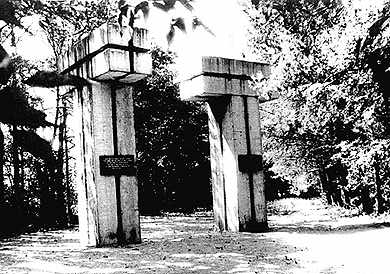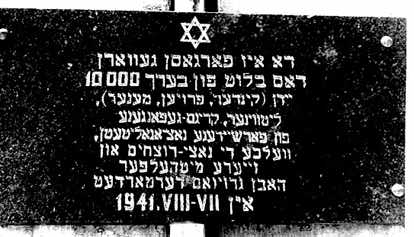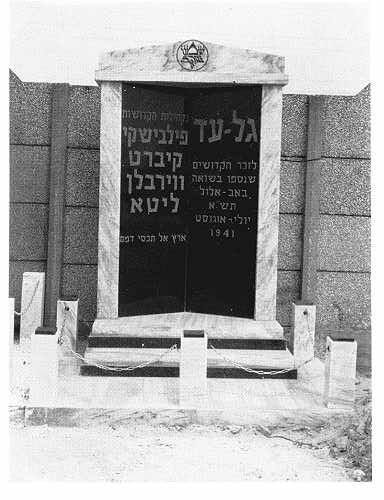
|


The monument established in 1991 on the mass graves near Virbaln where Kibart women and children were murdered.
The inscriptions in Lithuanian and Yiddish on the tables says:
"Here was spilled the blood of about 10,000 Jews (Men, Women and Children), Lithuanians, War Prisoners of different nationalities, who were cruelly murdered by the Nazi murderers and their helpers in July and August 1941"
Among the victims there were the author's mother, sister Tkhiyah, aunt Sarah and girl cousin Tsiporah Leibovitz.
Apparently the only Jew who heard everything, was Benjamin Jasven who in that barn; he was the owner of a sewing workshop of men's shirts in Kibart named "BeJa." He managed to hide and make his way to the Kovno Ghetto 12 days later. He managed to survive the three years of German rule in Kovno and after the liquidation of the Ghetto he was sent to the concentration camp of Dachau. After he survived Dachau he delivered his testimony to "The Committee for investigation of the crimes of the Nazis and their Lithuanian helpers" in 1947 in Munich.
The head of the Lithuanian gang who took part in the murder was the above mentioned vet Zubrickas. Other murderers were the Border Guard policeman Betinas, the policeman Zaganevicius, a German repatriate who returned to Lithuania named Lozovsky, the chief of the police Vailokaitis, the student Budrevicius - the son of the former mayor who was exiled to Siberia, the head of the agricultural society Orintas, and others.
After murdering the men and the youngsters, all women as well as the old and the children were concentrated in the red brick houses which had been emptied of Soviet soldiers. There they stayed for about a month and then all were transported, almost without any belongings, to the Ghetto in Virbalis.
The Ghetto in Virbalis was established in the almost empty streets where the repatriated Germans had lived before. The head of the Ghetto was the only dentist in town, Mrs. Sheine Pauzisky, who used to mix with those Lithuanians who were also her patients and had good connections in the state and municipal institutions.
A special shop was opened in the Ghetto for the supply of food. The shopkeeper was a Lithuanian, an honest man, who took care to supply the required quantities of food to the Ghetto inhabitants.
All young women and children aged 12-16 would go to various types of work in the town and the vicinity. A quasi employment bureau was established in the Ghetto where unemployed people would come to look for work and also peasants from the vicinity who would select women and youngsters for work. Among the employers there were evil and cruel people who treated the women and children very badly, but there were also brave people who maintained relations with the Jews. There were even some who hid 10 Jewish women when the murders began, but of the few women only Bela Mirbuch and her mother from Virbalis survived after hiding for 3 years at the farm of a Lithuanian teacher near the town where Bela worked as an agricultural worker. Bela Rosenberg too, the young daughter of farm owners near the town, survived after being hidden somewhere in the vicinity.
After a short time, one night at the end of July or at the beginning of August, all old women, the sick and all those who were unemployed were taken from the Ghetto and conveyed to the anti-tank trenches, about 2 kilometers north of the town, which the Russians had dug along the German border, where they were shot and buried.
After this "action" the authorities promised that nothing bad would happen to the Jews anymore and according to German methods of deception, the women were told that also their husbands were working in all sorts of jobs nearby. During this time, Lithuanians acquaintances and strangers would come and tell the women that they had seen their men and that they had asked for money, valuables or clothing, which the women would willingly hand over to them. These false requests increased from day to day and the women started to believe, wrongly of course, that maybe there was hope for them to see their beloved ones soon and even to join them. They believed what they wanted to believe and closed their ears to information about murder and extermination, which other women who worked outside told them.
Among the Lithuanian population there were rumors that the end of the rest of the Jews was near, but none came to warn them of this danger. The women lived with the illusion that they would join their husbands soon, baked, cooked and packed parcels. Then came the terrible day, Thursday September 11, 1941, the nineteenth of Elul 5701, when the Lithuanians arrived at night with carts, took all the women and children out to the anti-tank trenches and murdered them there in cold blood.
This was the tragic end of the Jewish Community of Kibart.
In May 1987 the monument in memory of the communities of Kibart (Kybartai), Virbaln (Virbalis) and Pilvishok (Pilvishkis) was unveiled at the cemetery in Holon. Zisl Kovensky, David Shadchanovitz, Frida Shtern-Rochman and Berta Seinensky-Sheines initiated and completed this important project on behalf of the former Kibart Community.

|
JewishGen, Inc. makes no representations regarding the accuracy of
the translation. The reader may wish to refer to the original material
for verification.
JewishGen is not responsible for inaccuracies or omissions in the original work and cannot rewrite or edit the text to correct inaccuracies and/or omissions.
Our mission is to produce a translation of the original work and we cannot verify the accuracy of statements or alter facts cited.
 Kibart (Kybartai), Lithuania
Kibart (Kybartai), Lithuania
 Yizkor Book Project
Yizkor Book Project
 JewishGen Home Page
JewishGen Home Page
Copyright © 1999-2024 by JewishGen, Inc.
Updated 13 Mar 2003 by LA